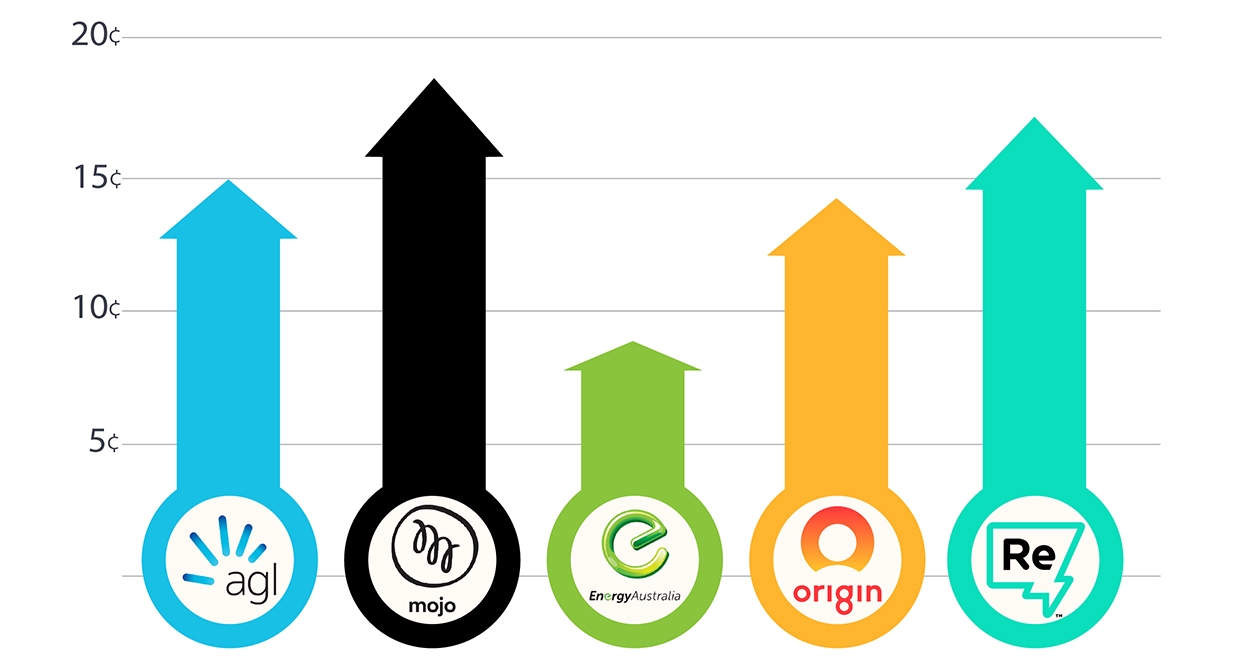Energy Provider Feed-in-Tarrif Comparison
This is, in short, an article on how to find the best energy provider for you, we’ll also explain it so you don’t have to be an electrician to understand. Most people get solar to save themselves money, in this article we’re going to have a look at feed-in-tariffs (how you make money), how they work, who pays the most, and what the best deals are for your system size. Read till the end for some quality tips!
First the Jargon:
Feed in tariffs (FiT) is a payment for electricity that you receive for feeding energy back into the grid from a renewable energy source. Basically, the extra energy you don’t use or need, each energy provider has an amount they are willing to pay per kilowatt for it.
An Inverter is the heart of your solar system. It is a box that will be located most likely in your garage or on the outside wall of your house that turns the energy generated by your system into power your home can use. Your inverter will come with a kilowatt rating; this will be slightly less than your system size. For example, a 13 kilowatt solar system will come with a 10 kilowatt inverter. This is to allow for general wear and tear – over time your solar system will slowly generate less power than the day it was first put in. Rest assured it is a small, generally unnoticeable amount, but to make sure your energy needs are covered for the longest time possible, we put a slightly larger system on your property. This is why your inverter will be rated lower than your solar system size.
Before you get solar installed:
When you sit down with a Solar consultant to discuss your power needs, the more information you can provide them with, the better the solar solution they can offer you. Their job is to find you a system that is big enough to cover your energy bill, but not too big that it becomes an overkill (unnecessarily costly). Please also note that having a larger system size does not automatically mean you will be generating more solar credits – until solar batteries become more affordable and commonplace, there is no need to have a huge system on your roof unless you are using most of the power yourself. The solar consultant must also take into account the unique attributes of your property, i.e., shade, roof style, location, the orientation of your house, etc. A great thing to have on hand are your previous power bills (try for a whole year if you can), and a rough idea of your biggest power needs, i.e., how often do you use your air conditioner and washing machine/dryer, and at what times?
Energy Providers and their Feed-in-tarrifs:
The energy game is always shifting – new energy providers pop up and the big guys are always doing something (most recently AGL bought Origin). There’s no need to watch it like the stock market (unless that’s your thing) but when it comes to making sure you’re getting the best feed-in-tariff (FiT) possible, a bit of research goes a long way. Alternatively, to save you time and energy, just read this article – we’ve done all the research for you.
It’s not just as simple as who pays the most cents per kilowatt; the fine print can make what seems like a great deal a little sour. For example, Mojo Power has the highest feed-in-tariff paying up to 20c per kilowatt (kWh), careful though, as that only extends up to the first 5.47kWh, after that it drops to 10c per kWh. If your system only generates a little over what you need each day, or you have a smaller system, this may be your best bet, as they will pay you the most on the market for your surplus energy. Dollar-wise, if you cap out their 5.47kWh offer daily, each day of the quarter you’ll end up roughly $90 in credit. Their reduced rate of 10c per kilowatt isn’t that bad, so keep them in mind.
The next two highest feed-in-tariffs go to some newer names, ReAmped at 17c per kWh, capped at 5kWh per day, and Discover Energy at 16c per kWh, capped at 3.28kWh per day. After the initial allowance is filled, both companies FiT’s drop to 5/6cents. ReAmped offers a unique online-only business model with no lock in contracts, if that is important to you.
AGL has the highest feed-in-tariff with no daily cap, offering 15c per kilowatt. The only condition is that your system size has to be 10kWh or below. If you have a larger system, never fear, simply check your inverter size, if it’s 10kWh or below, you still qualify. Your system should be slightly larger than your inverter in most cases anyway as this is to allow for general wear and tear. This ensures that you will have a large enough system for your energy needs over the longest period possible.
Energy Australia has differing FiTs for each state but has some notable differences from competitors when it comes to larger systems. They offer Queenslanders 8.5c per kilowatt and South Australians 10.5c per kilowatt, up to 30kWh. Victoria: 10.2c per kWh, New South Wales and Australian Capital Territory: 9.5c per kWh up to 10kWh.
Here is a chart from wattever.com.au that gives you a good overview of feed-in-tariffs for Queensland. Click the link to check your state!
| Retailer | Min Solar FiT | Max Solar FiT | Some Conditions | More provider information: |
| Mojo Power | 0.0c | 18.0c | High feed-in tariff on Gday Sunshine Time Of Use plan is capped to the first 5 kWh per day | Here |
| ReAmped Energy | 0.0c | 17.0c | High feed-in tariff on Solar plan is capped to the first 5 kWh per day | Here |
| Discover Energy | 6.0c | 16.0c | High FIT on Solar Smart plan is capped at 300kWh per quarter (3.28kWh per day) | Here |
| AGL | 6.0c | 15.0c | High feed-in tariffs on Solar Savers are limited to PV systems up to 10kW | Here |
| Red Energy | 6.0c | 15.0c | High FIT in NSW and Queensland is capped at 5kWh per day | Here |
| Origin Energy | 6.0c | 14.0c | Solar Boost Plus plans only available for eligible Origin solar PV systems and limited to 10kW maximum system size. | Here |
| Momentum Energy | 0.0c | 13.5c | Higher solar feed-in tariff plans are limited to PV systems up to 10kW. | Here |
| Alinta Energy | 0.0c | 11.0c | PV system is limited to 5kW inverter capacity. | |
| 1st Energy | 6.0c | 11.0c | ||
| CovaU | 0.0c | 11.0c | Here | |
| Diamond Energy | 0.0c | 10.2c | Feed-in tariff is only for systems up to 10kW unless agreed in writing by Diamond Energy. | Here |
| Enova Energy | 0.0c | 10.0c | Here | |
| Simply Energy | 10.0c | 10.0c | Here | |
| Dodo | 8.5c | 8.5c | ||
| Energy Locals | 8.5c | 8.5c | ||
| Energy Australia | 8.5c | 8.5c | Feed-in tariff is only for systems up to 10kW in ACT & NSW and 30kW in QLD and SA | Here |
| OVO Energy | 0.0c | 8.0c | Here | |
| Bright Spark Power | 6.0c | 8.0c | ||
| Elysian Energy | 1.0c | 7.9c | ||
| Ergon Energy | 7.9c | 7.9c | Here | |
| Locality Planning Energy | 0.0c | 7.9c | Lower solar FITs for SE Qld plans for systems 5-10kW and >10kW | |
| Glow Power | 7.0c | 7.0c | ||
| Sumo | 6.0c | 6.0c | ||
| Nectr | 0.0c | 6.0c | ||
| Powerdirect | 6.0c | 6.0c | ||
| Radian Energy | 6.0c | 6.0c | ||
| QEnergy | 0.0c | 5.5c | ||
| Future X Power | 4.0c | 4.0c | ||
| Electricity in a Box | 4.0c | 4.0c | ||
| Powershop | 0.0c | 3.5c | Feed-in tariff is only for systems up to 10kW in NSW QLD and SA. | Here |
| GloBird Energy | 3.0c | 3.0c | ||
| Kogan Energy | 2.9c | 2.9c | Here |
To summarise, every energy provider has their own fine print and terms and conditions, Mojo dropping to 10c per kilowatt after the first 5.47kWh is still more than a lot of other providers’ max feed-in-tariffs. AGL pays the most for 10kWh systems and under, and Energy Australia allows for 8.5c per kilowatt for Queenslanders, up to 30kWh. This small section of data shows that each energy provider has pros and cons to their feed-in-tariffs, the main question is which one best suits your energy needs.
What now? Well, like any education provider, we have some homework for you – trust us, it’s in your best interest!
Homework for you:
Not every energy provider allows you to take your money and run, some have a roll-over system.
This means that the credits you generate from your surplus energy may only be able to be used as credit for your future energy bills. Usually, the big names like Origin and AGL allow you to withdraw your credits. Once you have your top potential providers, give them a call as a prospective client and see what their policies are. Treat it as an interview for them, after all, you’re producing your own energy, so make them work for you.
An easy way to increase your feed-in-tarrif is to call your current energy provider and tell them you can get a better rate somewhere else; can they match it? Most often we use AGL as our baseline for customers, as their feed-in-tariff comes with the least amount of fine print. Dust off your haggling skills and have a crack at bartering, you won’t be using these skills in Thailand any time soon, so you may as well flex those muscles on your home turf. We have seen some customers get some impressive FiT’s by doing this..


